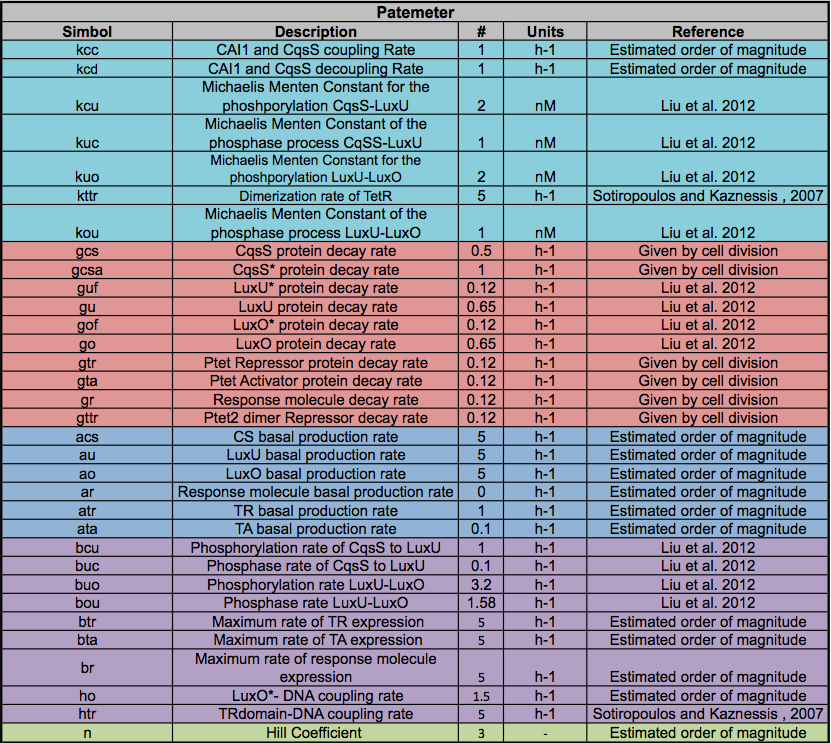Team:Colombia/Parameters
From 2014.igem.org
| Line 38: | Line 38: | ||
<b><font color="#8A0808" size="3" >Sensitivity analysis→ </font></b><br> | <b><font color="#8A0808" size="3" >Sensitivity analysis→ </font></b><br> | ||
| - | + | Some of the parameters only have an estimated order of magnitude and if their value is sensitive to the model we have to establish a better way to define the parameter. Also we wanted to know the importance of each parameters in the main outputs and how much each parameter affects the desired response. | |
| - | This test considered the following stages: i.) Establish the ranges of the parameters ( | + | This test considered the following stages: i.) Establish the ranges of the parameters (Include one or two orders of magnitude), ii) Determine appropriate division for the ranges, iii) Iterate each parameter while leaving the others fixed in the MATLAB code. iv) See how the difference between the steady state's concentrations and the concentrations during the impulse of the pathogen changed with the change of each parameter. |
| + | |||
| + | <b>Note: the exact value for each parameter is not important. It is important their relevance and how they change the response.</b> | ||
| + | |||
| + | Here we show the most important results: | ||
<br> | <br> | ||
| - | |||
| + | <br> | ||
<b><font color="#8A0808" size="3" >References → </font></b><br> | <b><font color="#8A0808" size="3" >References → </font></b><br> | ||
Revision as of 23:48, 30 September 2014
The Parameters
The numbers that define our destiny....
There are three possible ways to find this parameters (taken from Colombia 2012):
a) Literature: There are a lot of studies trying to find parameters for biological systems; but only a few of them have been characterised. Luckily for our project the Quorum Sensing of V. cholera and the pTEt inversor have been studied and we found a lot of parameters.
All of the Parameters found in the table below were taken from the literature (see references), when the exact parameter were not found we estimated an order of magnitude.
b) Experimental way: If an experiment is made using the biological system of interest, it is possible to find the parameters for the equations that models the whole system. For this project, it was necessary to model the biological system first. Thus, experiments couldn't be performed to find the constant for the differential equations.
c) Screening of parameters: Sometimes we don't have the exact number that we need, but we have a rank where it could be or the parameter for a similar biological system, then we can perfom a screening of parameter, where we try to find the value that perfectly fits the reponse of our circuit. We designed a screening of parameters that can be made for any team :D , check you this page for more information: DO IT YORSELF! .
Sensitivity analysis→
Some of the parameters only have an estimated order of magnitude and if their value is sensitive to the model we have to establish a better way to define the parameter. Also we wanted to know the importance of each parameters in the main outputs and how much each parameter affects the desired response.
This test considered the following stages: i.) Establish the ranges of the parameters (Include one or two orders of magnitude), ii) Determine appropriate division for the ranges, iii) Iterate each parameter while leaving the others fixed in the MATLAB code. iv) See how the difference between the steady state's concentrations and the concentrations during the impulse of the pathogen changed with the change of each parameter.
Note: the exact value for each parameter is not important. It is important their relevance and how they change the response.
Here we show the most important results:
References →
Liu, X., Zhou, P., & Wang, R. (2012, August). Switch-like regulation of signal transduction by small RNA-mediated quorum sensing. In Systems Biology (ISB), 2012 IEEE 6th International Conference on (pp. 164-168). IEEE.
Sotiropoulos, V., & Kaznessis, Y. N. (2007). Synthetic tetracycline-inducible regulatory networks: computer-aided design of dynamic phenotypes. BMC Systems Biology, 1(1), 7.
 "
"






